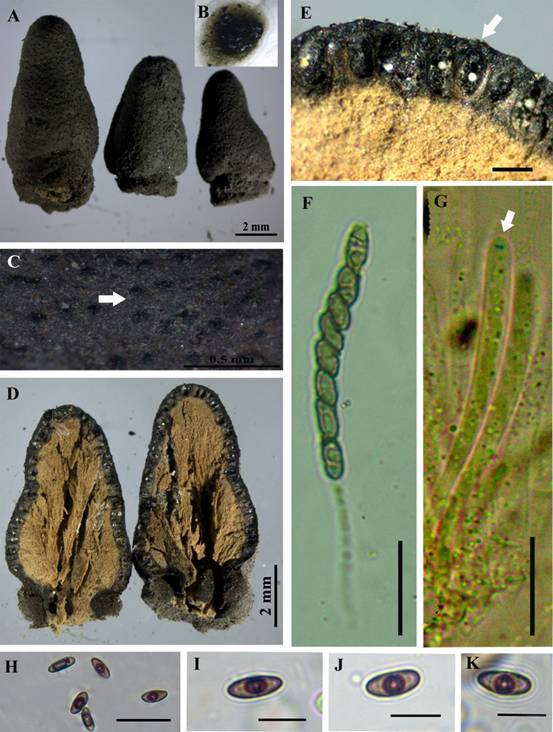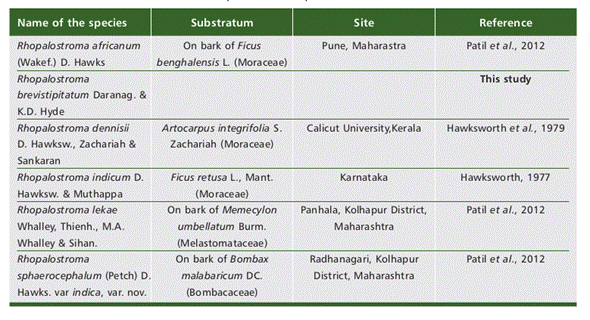INTRODUCTION
In 1977, Hawksworth established the genus Rhopalostroma with the type species Rhopalostroma indicum Hawksw. & Muthap from Karnataka, India. The genus Rhopalostroma is characterized by pedicellate, erect stromata, which are either simple or occasionally branched, melanized, and mature stromata that become carbonaceous with expanded convex heads. The internal flesh is dark-brown to black without concentric zones. Multi-perithecia are regularly and superficially arranged in a sin- gle-layer form (monostichous). The asci are evanescent, meaning they are destroyed at maturity (except for Rhopalostroma brevistipitatum); the asci are cylindrical, am- yloid, or inamyloid. Usually, fresh stromal tissue in a 10% KOH solution yields a greenish or olivaceous pigment or is absent.
A conidial state is produced in the culture of a few species, resembling nodulis- porium-like (Hawksworth & Whalley, 1985; Stadler et al., 2010; Daranagama et al., 2014). Morphologically, this genus Rhopalostroma is closely related to Phylacia due to its globose to subglobose stromata; however, it differs from Phylacia in having a single layer of ascomata in the stroma, asci with apical apparatus, and ascospores with a germ slit. Based on asexual morph, phylogenetic analysis and secondary metabolite profiling, this genus is firmly placed within the family Hypoxylaceae (Wendt et al., 2018).
Globally, this genus comprises a total of 11 validly published species, of which five species were previously reported from India.
MATERIALS AND METHODS
Morphological traits were examined using a stereozoom microscope (Stemi58). Slide were prepared for compound microscopy to observe various structures of the stro- mata, including perithecia, ostioles, asci, paraphyses, periphyses, and ascospores, by using a compound microscope (Zeiss A1). The 10% KOH test was conducted by adding a few drops of 10% KOH solution to a small amount of stromatic tissue (Ju & Rogers, 1996). Color designation was determined by Rayner’s guidelines (1970). To determine the ascal apical apparatus, Melzer’s reagent reaction was employed. Measurements of different characters such as stromata (n=10), ascomata (n=10), and ascospores (n=40) were taken from materials mounted in water, and the mean values were utilized in the descriptions. The validity of the species name was cross- checked using Index Fungorum and MycoBank. Photographs were produced using Adobe Photoshop.
RESULTS
Taxonomy
Rhopalostroma brevistipitatum Daranag. & K.D. Hyde, in Daranagama, Liu, Chamyuang, Stadler, Bahkali & Hyde. Fig. 1: A-K
MycoBank Nº 550815
Teleomorph.- Stromata (3-)5-7(8) mm high x (3-)3.5-4.0(-4.3) (av. 5.8 x 3.7 mm), erect, scattered distribution, solitary, hard, not fused and not branched, light brown to purplish brown, carbonaceous stromata at mature. Stipe (1-)1.7-1.8(-2.6) × (1.8-
)2.3-3.4(-3.8) mm (av.1.6 × 2.8 mm), short and stout, tightly attached, infertile. Head (2-) 4.1-4.2(-5.2) × (2.8-)3.0-3.5(-4.0) mm (av. 4.15 × 3.2 mm), expanded,
optuse, clavate, fertile. Stromatal pigments is Dull Green (70) in 10% KOH test. As- comata (0.213-)0.311-0.364(- 0.383) × (0.151-)0.167- 0.202(-0.212) mm (av. 0.341×
0.187 mm), immersed directly beneath the ectostroma surface, regularly and super- ficially arranged in a single layer of perithecia, hemispherical to sub-cylindrical, perithecia with pappilate ostioles. Paraphyses slightly longer than asci, filamentous, aseptate. Asci (78-)82-101(-106) μm (av. 96 μm) in total length, stipitate, cylindrical, unitunictae, uniseriate with 8 ascopspres, apical apparatus not cleared. Ascospores (9.12-)10.0-11.0(-11.73) × (3.5-)3.8-4.7(-5.0) μm (av. 10.5 × 4.1 μm), uniseriate,
olivaceous (48), equilaterally-ellipsoidal, uniguttulated, with broadly rounded ends, epispore smooth, perispore indehiscent in 10% KOH, germ slit straight.
Asexual morph.- Mycelia simple to complex, hyaline, dichotomously branched, nodulisporium-like. Conidiogenous cells produced throughout the mycelia. Conidia (3-)4-5(-6.9) × (2-)2.7-3(-3.2) μm (av. 4.7 × 2.8 μm), hyaline, single, ellipsoidal, with one pointed end and one blunt end.
Distribution.- Thailand (Daranagama et al., 2015).
Habitat.- Saprophytic on semi-decaying bamboo.
Material examined.- INDIA. Arunachal Pradesh, Papum Pare district, Rajiv Gandhi University (27º11’245”N 093º35’49”E; 577 masl.), on the bamboo host as a saprophytic condition, tropical forest, 03-II-2020, coll. by G. Dutta & R. K. Singh, specimen is deposited in Botanical Survey of India, Itanagar, Arunachal Pradesh, India, Voucher number: ARUN- 40951 and additional specimen is deposited in De- partment of Botany, Rajiv Gandhi University, Arunachal Pradesh, Voucher number: ARFR- 808.
Notes.- The newly reported species, Rhopalostroma brevistipitatum, is morpholog- ically very similar to the holotype species in all aspects (Daranagama et al., 2015). This species is characterized by small and solitary stromata with short and stout stipes, and cylindrical asci with a J+ discoid apical apparatus. However, in our ex- amined species, we were unable to identify a clear apical apparatus. Furthermore, it’s worth noting that the holotype species was originally described as saprobic on decaying bark, while the present species was discovered in saprophytic conditions on dead bamboo. Furthermore, this species bears a resemblance to Xylaria badia Pat. however, it exhibits notable differences. The most prominent distinction lies in the smaller stromata height, av. (3-)5-7(8) mm vs. (2.5-)5-15(-28) mm. Additionally, the fertile portion of the stroma is shorter with obtuse apex, and the stipe is con- siderably shorter than that of X. badia. The surface color also sets them apart, with the present species displaying a light brown to purplish-brown, in contrast to X. badia’s grayish-brown to silvery-gray appearance. Moreover, while the inner stromata of X. badia are soft-textured, solid, spongy, and white to tan, the present species is predominantly hard, creamy white to brown, and characterized by cracks. The size of the perithecia and asci is nearly identical, with dimensions of 0.341 × 0.187 mm vs. 0.3-0.35 × 0.2-0.3 mm. However, there is a slight variation in the size of the ascospores, with the present species having slightly larger ascospores av. 10.5 × 4.1 μm vs. 9.4 × 3.9 μm (Fournier et al., 2020).

Fig. 1 Macroscopic and microscopic features of Rhopalostroma brevistipitatum: A) Stromata. B) Extractable pigments in 10% KOH. C) Ostioles (arrow) on stroma surface. D) Longitudinal section showing perithecial ascomata at the periphery of the stroma with superficial perithecia. E) Perithecia (arrow). F) Ascus. G) Immature asci with apical apparatus (arrow). H) Different shapes of ascospores. I-K) Uni-guttulate ascospores. Scale: E= 0.2 mm. F,G,H= 20 µm. I-K= 10 µm.
Fig. 1. Características macroscópicas y microscópicas de Rhopalostroma brevistipitatum: A) Estromas. B) Pigmentos extaríbles con KOH 10%. C) Ostiolos visibles (flecha) en la superficie del estroma. D) Corte longitudinal del estroma mostrando ascomas periteciales en la periferia, con peritecios super- ficiales. E) Peritecios (flecha). F) Asco. G) Ascos inmaduros con aparato apical (flecha). H) Diferentes formas de ascosporas. I-K) Ascosporas uni-gutuladas. Escala: E= 0.2 mm. F,G,H= 20 µm. I-K= 10 µm.
DISCUSSION
The generic distribution is limited to tropical and subtropical regions in Africa and Asia (Hawksworth, 1977). The distribution of the species Rhopalostroma brevistipi- tatum is confined to the northern region of Thailand. Morphologically, this species resembles immature Xylaria spp. due to its very small clavate-shaped stromata. In comparison, R. brevistipitatum is much smaller than other Rhopalostroma species. Ad- ditionally, most Rhopalostroma species have deliquescent asci, making it challenging to properly identify the apical apparatus of the asci. However, R. brevistipitatum has a minute apical apparatus that appears blue in Melzer’s reagent (Daranagama et al., 2015). The anamorph produced is nodulisporium-like, similar to R. angolense and
R. lekae (Hawksworth, 1977; Stadler et al., 2010; Daranagama et al., 2014). Before the addition of the presently reported species, R. brevistipitatum, India had only five different species of Rhopalostroma. With the addition of the present species R. brevis- tipitatum, the total number of species for the genus in India increases to six (Table 1).















